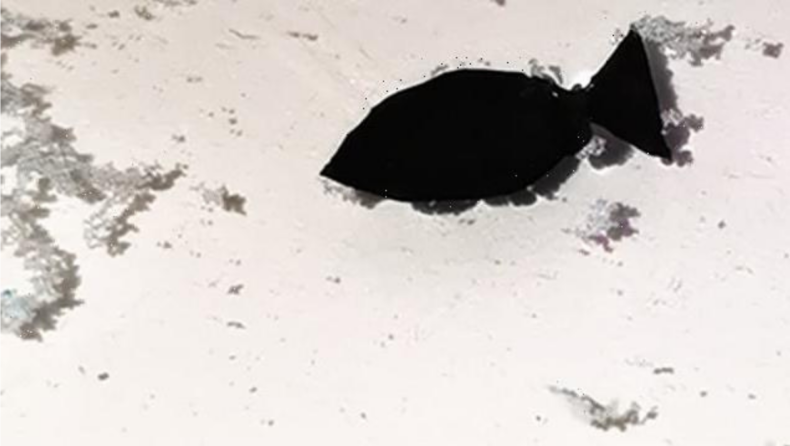Tiny self-propelled robot-fish can swim around, latch on to microplastics that are free-floating in the sea, and repair themselves in case of damage.
- Scientists have designed a tiny self-propelled robot-fish to remove microplastics from water bodies.
- The material used in the construction of the fish, which is similar to nacre, has regenerative properties and can adsorb microplastics.
- Currently only functions on water surfaces. Further study will develop advanced models that will be capable of travelling deeper under-water.
Scientists have designed a tiny robot-fish that is programmed to clear microplastics from the seas and oceans by swimming around and adsorbing them on its soft, flexible, self-healing body.
The robo-fish is just 13mm long. It swims and flaps around at almost 30mm a second, owing to the light laser system in its tail. This speed is similar to the speed at which plankton drift around in moving water.
Microplastics are the billions of minute particles of plastic that break off of the larger plastic items that are used on a daily basis, such as water bottles, vehicle tyres, and synthetic T-shirts.
They are one of the biggest environmental issues of the 21st century because once they are released and diffused into the environment through the breakdown of larger plastics, they are very difficult to eliminate. They end up in drinking water, produce, and food, harming both the environment and the health of humans and animals.
Researcher Yuyan Wang at the Polymer Research Institute of Sichuan University is one of the lead authors of the study. She considers the development of a robot that is capable of precise collection and sampling of detrimental microplastic pollutants from the aquatic environment to be of great importance. Her team’s unique invention is described in a research paper in the journal Nano Letters.
It is claimed to be the first soft robot, to the best of anyone’s knowledge.
Researchers at Sichuan University have devised an innovative solution to track down these pollutants that are responsible for water contamination.
They have designed a tiny self-propelled robo-fish that can swim around, latch on to free-floating microplastics, and heal itself in case it gets cut or damaged while on its expedition.
The robot is made from materials inspired by elements that thrive in the sea. Mother-of-pearl, also called nacre, is the covering on the inside of clam shells.
The researchers’ team created a material almost identical to nacre by layering various microscopic sheets of molecules according to nacre’s specific chemical gradient.
According to the study, the resulting robo-fish is stretchable, flexible to twist, and even capable of pulling up to 5 kg in weight.
The organic colours, antibiotics, and heavy metals in the microplastics have strong chemical bonds and electrostatic interactions with the fish’s materials.
This is the reason why bionic fish can adsorb surrounding free-floating microplastic particles. This causes the microplastics to adhere to its surface, thus enabling the fish to gather and remove microplastics from the water.
The researchers can further examine the composition and physiological toxicity of the microplastics once the robot collects them from the water.
In addition to this, the newly invented material also seems to have regenerative abilities. Wang specialises in the development of self-healing materials.
In the case that the robot fish experiences damage or cutting-which could happen often when it goes hunting for pollutants in rough waters-it has the potential to heal itself to up to 89% of its ability and continue adsorbing.
Wang points out that this is only a proof of concept and that much more investigation is required, particularly into how this may be applied in the real world.
For instance, the soft robot currently only functions on water surfaces. Thus, in the near future, Wang’s team will be working on more functionally complicated robo-fish that can travel deeper under the water.
Wang believes that nanotechnology has significant promise for the trace adsorption, collection, and detection of contaminants, enhancing intervention efficiency while lowering operating costs. Nonetheless, this bionic design could serve as a starting point for subsequent studies of a similar nature.
Nanotechnology for Prevention
Philip Demokritou, the director of the Nanoscience and Advanced Materials Research Centre at Rutgers University, agrees that nanotechnology will be one of the prime players in the fight against microplastics. Although he was not involved in this study, his lab also focuses on utilising nanotechnology to eradicate microplastics from Earth.
Instead of cleaning the microplastics up, they are working on substituting them.
This week, in the journal Nature Food, he announced the invention of a new plant-based spray coating that can serve as an environmentally friendly alternative to plastic food packaging.
Their case study showed that this starch-based fibre spray can fend off pathogens and guard against transportation damage just as well, if not better, than current plastic wrapping options.
“The motto for the last 40 to 50 years for the chemical industry is: let’s make chemicals, let’s make materials, put them out there and then clean the mess 20, or 30 years later,” said Demokritou. “That’s not a sustainable model. So can we synthesise safer design materials? Can we derive materials from food waste as part of the circular economy and turn them into useful materials that we can use to address this problem?”
According to Demokritou, this is a low-hanging fruit for the study of nanotechnology. As material science advances, so will the multi-pronged approach of replacing plastic in our daily lives and filtering out its microplastic waste from the environment.













